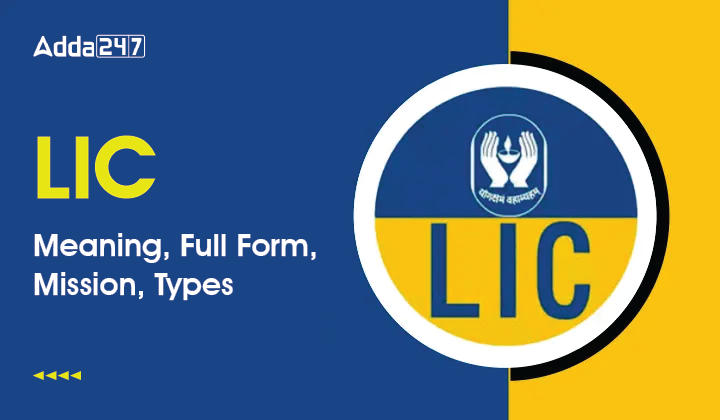Table of Contents
Life Insurance refers to a contract between an insurance policy holder and an insurance company, where the insurer promises to pay a specified amount in exchange for a premium, after a set period or upon the death of an insured person. Following are the major historical developments in the arena of life insurance:
UGC NET Commerce Notes PDF & Study Materials
LIC Overview
- The modern form of Life Insurance came to India in the year 1818 from England
- Oriental Life Insurance Company was started by Europeans as the first life insurance company in Calcutta on Indian Soil.
- This insurance company only caters to the life insurance needs of Europeans, not Indians because they are considered to have substandard lives. Then comes several advancements.
- Bombay Mutual Life Assurance Society, the first Indian life insurance company started its business in 1870.
- By the year 1950s, there were many Indian and foreign insurance companies in India.
- Then in the year 1956, the Indian government took over 245 Indian and foreign insurers and provident societies and nationalised them. The government then passed LIC Act, 1956, and formed LIC (Life Insurance Corporation) as a statutory body with a capital contribution of Rs. 5 crores. This is how Life Insurance Corporation came into existence in the year 1956 with an aim of providing Life Insurance services to Indians.
Full Form of LIC
The full form of “LIC” is “Life Insurance Corporation.” It is an Indian state-owned insurance and investment company that provides various life insurance products and services to individuals and groups. The Life Insurance Corporation of India (LIC) is one of the largest insurance companies in India and is headquartered in Mumbai.
| Full Form of LIC | |
| Name | Life Insurance Corporation of India (LIC) |
| Type | State-owned insurance and investment company |
| Founded | September 1, 1956 |
| Headquarters | Mumbai, India |
| Chairman | Shri. Siddhartha Mohanty |
| Products and Services | LIC offers a wide range of life insurance products and services, including individual life insurance plans, group insurance plans, pension plans, investment-linked insurance plans, and more. |
| Government Ownership | LIC is wholly owned by the Government of India. |
| Official website | https://licindia.in/home |
LIC Meaning and Concept
LIC, or Life Insurance Corporation of India, is a state-owned insurance company in India. It was founded in 1956 by the Indian government, with the goal of promoting life insurance and encouraging savings among the Indian population.
Since its inception, LIC has grown to become the largest life insurance company in India, with a market share of more than 70%. The company has a presence in over 2000 locations across India and offers a wide range of insurance products to meet the diverse needs of its customers.
LIC Mission and Vision
Mission: Their mission is to enhance the quality of life by providing people with financial security through our range of highly sought-after products and services which offer competitive returns. We strive to provide resources for economic development to further this goal.
Vision: Their vision is to become a highly competitive financial conglomerate that is recognized globally and is a source of pride for India’s people and society.
LIC Facts
The Life Insurance Corporation of India (LIC) is a premier life insurance provider based in Mumbai. With an asset value exceeding 2,529,390 crores, it is the largest life insurance company in India, with a presence in both urban and rural regions of the country. As of today, LIC of India operates with:
- 1,53,070 individual agents
- 345 corporate agents
- 110 referral agents
- 120 brokers
- 42 banks
- 2048 fully computerized branch offices
- 113 divisional offices
- 1381 satellite offices
- 10 zonal offices
LIC Highlights
- IPO: In 2021, the Indian government announced plans to sell a portion of its stake in LIC through an initial public offering (IPO). This move is expected to raise significant capital for the government, and will also give the public an opportunity to invest in one of India’s most trusted brands.
- Digitalization: In recent years, LIC has been investing heavily in digitalization, with the aim of improving customer experience and increasing efficiency. The company has launched several digital platforms, such as the LIC app and e-Services portal, which allow customers to access their policy information and make online transactions.
- Covid-19 relief measures: During the Covid-19 pandemic, LIC took several steps to support its customers and employees. The company introduced several measures to facilitate online transactions and also offered special insurance policies and financial assistance to healthcare workers and Covid-19 patients.
- Awards and recognition: LIC has received several awards and recognition in recent years, including the ‘Most Trusted Life Insurance Brand’ award at the Brand Trust Report in 2021. The company has also been recognized for its CSR initiatives and its commitment to financial inclusion.
Role of LIC in the Indian Economy
LIC is the first statutory body in India to provide life insurance services that help policyholders to mitigate the risk associated with life. It gathers money via premiums collected from policyholders and invests funds in financial markets. The following are major roles performed by LIC:
- Supporting Government initiatives: LIC also supports government initiatives like Pradhan Mantri Jeevan Jyoti Bima Yojana (PMJJBY) and Pradhan Mantri Suraksha Bima Yojana (PMSBY) by providing coverage to eligible beneficiaries.
- Investment in infrastructure: LIC invests in various infrastructure and development projects, which help in the economic growth of the country.
- Creating job opportunities: LIC provides employment opportunities to thousands of Indians through its various branches across the country.
- Supporting the rural economy: LIC plays a crucial role in supporting the rural economy through its micro-insurance products, which provide coverage to farmers and rural communities.
- Contribution to the GDP: LIC’s contribution to the Gross Domestic Product (GDP) of India is significant, as it is one of the largest insurance providers in the country.
- Loan Provider: Provides various loans like direct loans to industries, housing loans, and loans to various national projects at reasonable interest rates.
Types of LIC Life Insurance Plans
There are various types of LIC Life Insurance Plans available in India that cater to different needs and preferences of individuals which are as follows:
- Term Insurance: Term insurance is a type of life insurance that provides coverage for a specific period of time, typically ranging from 1 to 30 years. It offers a death benefit to the policyholder’s beneficiaries if the policyholder passes away during the term of the policy. The premium for term insurance is generally lower than other types of life insurance because the coverage is temporary and does not accumulate cash value. If the policyholder outlives the term of the policy, the coverage will expire, and no death benefit will be paid out.
- Endowment Plans: Endowment plan is a type of life insurance policy that combines insurance coverage with a savings component. These plans provide a guaranteed sum of money to the policyholder at the end of a predetermined period, which can range from 10 to 30 years, or upon the policyholder’s death, whichever occurs first. Endowment plans typically have higher premiums than term insurance policies because they provide both insurance coverage and a savings element. The savings portion of the plan earns interest or investment returns, and policyholders may be able to withdraw or borrow against the savings portion of the policy. Endowment plans are often used for long-term financial planning goals such as saving for a child’s education or for retirement.
- Money-Back Plans: Money-back plan is a type of life insurance policy that provides regular payouts to the policyholder during the term of the policy. These plans combine insurance coverage with a savings component, much like endowment plans. The policyholder receives a percentage of the sum assured at regular intervals, which can range from yearly to every few years, and at the end of the policy term, the remaining sum assured is paid out to the policyholder. If the policyholder dies during the term of the policy, the full sum assured is paid out to the beneficiaries. Money-back plans offer a guaranteed return on investment and provide a way to save for specific financial goals while also providing life insurance coverage.
- Whole Life Insurance: Whole life insurance is a type of life insurance policy that provides coverage for the entire lifetime of the policyholder, as long as premiums are paid on time. These policies offer a death benefit to the policyholder’s beneficiaries when the policyholder passes away, and they also include a savings component that accumulates cash value over time. The cash value of the policy grows tax-deferred, and the policyholder may be able to borrow against it or withdraw it. Whole life insurance policies typically have higher premiums than term insurance policies because they provide lifelong coverage and build cash value. Whole life insurance is often used for long-term financial planning goals such as estate planning or leaving a legacy to beneficiaries.
- Pension Plans: A pension plan is a type of retirement plan that provides income to individuals during their retirement years. These plans are typically offered by employers as a benefit to their employees. Pension plans can be funded by the employer, the employee, or a combination of both. The contributions made to the plan are invested and grow over time, and upon retirement, the plan pays out a predetermined income to the retiree. Pension plans may be either defined benefit plans, which provide a specific benefit amount to retirees, or defined contribution plans, which provide retirement income based on the number of contributions and investment returns. Pension plans provide a way for individuals to save for retirement and ensure a stable income stream during their golden years.
- Child Plans: Child plan is a type of life insurance policy that is designed to financially secure a child’s future. These plans provide a combination of life insurance coverage and savings and are typically purchased by parents or guardians on behalf of their child. The policy provides a lump sum payout when the child reaches a certain age, typically 18 or 21 years, which can be used to pay for the child’s education or other expenses. If the policyholder, who is usually the parent or guardian, passes away during the term of the policy, the child will receive the death benefit payout. Child plans usually have a longer policy term than other types of life insurance policies, typically ranging from 10 to 25 years, and may include features such as premium waivers or guaranteed insurability, which allow the child to purchase additional coverage in the future without having to undergo a medical underwriting.
- ULIPs: ULIP is a type of life insurance policy that combines life insurance coverage with investment options. It allows the policyholder to invest a portion of their premium in a range of investment funds and also provides a death benefit to the beneficiaries. The policyholder can choose the level of investment risk and the returns earned on the investment portion are tax-free. ULIPs offer flexibility and transparency, but they also have higher fees compared to other policies. ULIPs are typically used for long-term financial planning goals such as retirement planning or wealth accumulation.
- Group Insurance: Group insurance is an insurance policy that covers a group of people, such as employees or members of an organization, under a single policy. It can provide various types of coverage such as life insurance, health insurance, and disability insurance. The premiums for group insurance policies are usually lower than individual policies because the risk is spread out among the group. Group insurance policies may offer favourable terms and conditions, such as no medical underwriting, and are often offered as an employee benefit to attract and retain employees. This allows members of the group to obtain insurance coverage at a lower cost than individual policies.
Thus, LIC has been able to establish itself as a trustworthy insurance provider in India by providing a wide range of insurance products and investment options to individuals and organizations. The company has been able to create a loyal customer base due to its customer-centric approach and excellent after-sales support. With its strong distribution network and innovative products, LIC is well-positioned to continue its growth trajectory and remain a market leader in the insurance industry.
Download UGC NET Commerce Study Note PDF
To Download the UGC NET Commerce Study Note PDF, candidates must click on the following link. It is beneficial for the candidates to download and save the UGC NET LIC Study Note PDF to easily refer to it during preparation and revision
Download LIC Notes For UGC NET, Meaning, Full Form, Mission, Types




 समुद्र का पर्य�...
समुद्र का पर्य�...
 उपमा अलंकार: पर�...
उपमा अलंकार: पर�...
 समास परिभाषा, भ�...
समास परिभाषा, भ�...














